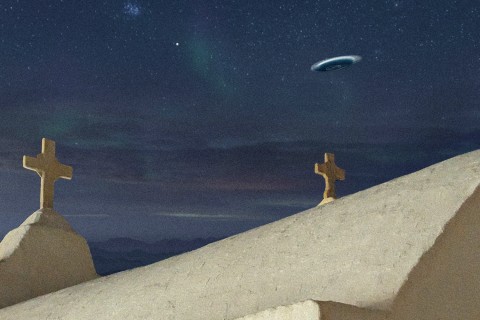Christ-haunted landscape: Leviticus 19:1-2, 15-18
Leviticus wants to draw a clear line between God and God's creation.
When I read Leviticus, I can almost see the mini-blinds being swiveled shut on the everyday world. Leviticus, after all, holds to a God who is Wholly Other. The creation, including humankind, is fashioned by divine hands but not out of divine stuff. This was not the theology of the world surrounding Leviticus, whether you date the book pre- or post-Exile.
The "Enuma Elish," the Babylonian creation epic, for example, has the young god Marduk splitting the rebel Tiamat "like a shellfish" and creating the heavens out of one part and the earth out of the other. He fashions humankind from the blood of Kingu, her vanquished consort. The result is a paradox. The view of creation, especially humankind, is low, for humans are created to be slaves of the gods. Yet humans are made from divine matter, and contain a spark of the divine.
The biblical view of creation presents the paradox in reverse. The view of humankind is high—humans are the crown of a creation that God calls good every step along the way and, finally, very good. But in this case humans lack even a suspicion of divinity in their DNA. This frees us from the mischief that comes from thinking we are going to bring in the ideal age, whether that is the Thousand Year Reich, the Workers' Paradise or the Age of Aquarius. Rather, we look to God to bring about God's redemptive reign. We give thanks to God for whatever role we might have in God's workings.
The Book of Leviticus wants to draw a clear line between God and God's creation. It is easy, however, to view this line as a boundary between us ("your people," "your kin") and them, those people who look different, act differently and think differently. Witness, for example, what becomes of the Golden Rule when Matthew Hale, leader of the World Church of the Creator, says that whatever is for the white race is good and whatever is against the white race is evil, is sin. "That is the Golden Rule," says Hale.
Leviticus is misread when it is used to set a boundary line between people. Yet the proposition is enticing. God's people are always, it seems, in danger of being overwhelmed by the larger and dominant culture surrounding them. The worship of Yahweh looked pretty boring compared to the Canaanite fertility cult. Returning exiles had all they could do not to be absorbed by the people who had filled the vacuum created by their absence. We have all we can do to maintain our integrity as the people of God, enmeshed as we are in a culture that lives by a debit/credit economy of human relations and an ethic of keeping score and getting even. In many ways it is them against us. However, the purpose of Leviticus is not to swivel the mini-blinds shut, but to throw them open to God.
Although God is Wholly Other, God is not separate and uninvolved. The sacrificial cult detailed in the first 16 chapters of Leviticus sits down to table fellowship with this God. And the moral behavior mandated in the holiness code prepares God's people to become involved as witnesses to God's character and God's rule.
As the people of God, we are commanded to live in such a fashion that the world around us gets a glimpse of what God is like. We witness to the redemptive reign of God, which God promises to effect. Living by the rule of Leviticus 19, we point to a God whose justice is ruled by love, who makes provision for the poor and will not allow the disabled to be disadvantaged. Obeying the commands prohibiting stealing and slander upholds the integrity of others and shows God's high regard for us in giving such commands.
The sacrifices detailed in Leviticus cover a range of purposes and human needs, from thanksgiving to atonement. While I view table fellowship with God as the constant over the whole range, atoning for human failure is at least a part of what God provides for in sacrifice. So, within the sacrificial cult, the people of God reveal God to be merciful.
For me, Leviticus is a Christ-haunted landscape. I see Christ in the wilderness shadows, moving from salt pillar to boulder much like the Christ of Hazel Motes in Flannery O'Connor's novel Wise Blood. In different terrain he sees "Jesus move from tree to tree in the back of his mind, a wild ragged figure motioning him to turn around and come off into the dark, where he was not sure of his footing, where he might be walking on water and not know it." In Leviticus Christ motions from behind the type on the printed page.
Perhaps this way of reading is unavoidable for me, given that my forebears in the faith have drilled it into me always to ask, "So, why do I need a crucified and risen Savior?" And: "What does the text have to do with the text's Lord, who is Jesus Christ?"
Talk about provision for human failure, and I see Jesus stumbling up a wilderness trail with a cross on his back. Talk about sacrifice and a fellowship meal with God, and I smell wine and feel the host crunch in my hands. Talk about the clear line between God and creation, and I think of the one who blurred it, the Son of God, who is virgin born, true God and true human, 100 percent of each.
Leviticus, like the rest of scripture, looks to God to bring in the redemptive reign of God, which will look like a world living out the provisions of Leviticus 19, which looks like the life of Christ. With every splash of baptism water we celebrate the extension of God's jurisdiction and the part we have to play in it.





